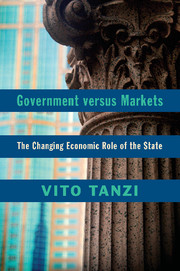Book contents
- Frontmatter
- Contents
- Preface
- PART ONE THE ECONOMIC ROLE OF THE STATE
- PART TWO HISTORICAL REVIEW
- 2 The Role of the State in the Pre–World War II Period
- 3 Forces That Changed the Role of the State
- 4 Growth of Public Spending and Taxation in the 20th Century
- 5 The Role of the State in Social Protection
- 6 Globalization and Public Spending
- PART THREE THEORETICAL AND ANALYTICAL ISSUES
- PART FOUR THE OUTCOME OF STATE INTERVENTION
- PART FIVE ON THE ECONOMIC ROLE OF THE STATE IN THE FUTURE
- Notes
- Index
- References
2 - The Role of the State in the Pre–World War II Period
Published online by Cambridge University Press: 07 October 2011
- Frontmatter
- Contents
- Preface
- PART ONE THE ECONOMIC ROLE OF THE STATE
- PART TWO HISTORICAL REVIEW
- 2 The Role of the State in the Pre–World War II Period
- 3 Forces That Changed the Role of the State
- 4 Growth of Public Spending and Taxation in the 20th Century
- 5 The Role of the State in Social Protection
- 6 Globalization and Public Spending
- PART THREE THEORETICAL AND ANALYTICAL ISSUES
- PART FOUR THE OUTCOME OF STATE INTERVENTION
- PART FIVE ON THE ECONOMIC ROLE OF THE STATE IN THE FUTURE
- Notes
- Index
- References
Summary
Introduction to the Historical Review
The following five chapters in Part II present a historical review of the changing economic role of the state. Much of the review deals with the 19th and 20th centuries. The review discusses various factors and refers to some economists who contributed to changes in the perception of what responsibilities states have in the economy and to actual changes in the economic activities of governments over the two centuries. As a background to that review, it should be recalled how attitudes toward poverty, income distribution, and the opportunities faced by individuals changed over long periods of time. While recognizing some exceptions and some differences among countries, we can distinguish three general periods.
In the first period, which extended from the Middle Ages to the first half of the 19th century, the social and economic status of a person depended largely or almost exclusively on birth. Family and family connections were by far the most important factors. Poverty (or a low-class status) was seen as a natural condition of part of humanity. Sergio Ricossa ([1986] 2006) quotes the words of Giordano da Rivalto (o da Pisa), a monk who was a famous theologian and preacher at the beginning of the 13th century: “If all were king, who would work the land? God has ordained that there must be rich and poor so that the rich are served by the poor, and the poor are helped by the rich” (my translation).
- Type
- Chapter
- Information
- Government versus MarketsThe Changing Economic Role of the State, pp. 39 - 71Publisher: Cambridge University PressPrint publication year: 2011



